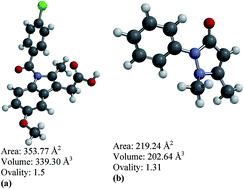Micro-/mesoporous carbons for controlled release of antipyrine and indomethacin
Abstract
We have demonstrated the potential of meso- and microporous carbons in controlled release applications and targeted oral drug delivery. We have employed two mesoporous and two microporous carbons for the sustained release of one water-soluble drug (antipyrine) and one water-insoluble drug (indomethacin), using these as models to examine the controlled release characteristics. The micro-/mesoporous carbons were characterized as having a BET surface area of 372–2251 m2 g−1 and pore volume 0.63–1.03 cm3 g−1. The toxicity studies with E. coli bacterial cells did not reveal significant toxicity, which is in accordance with our previous studies on human cells with similar materials. Mucin adsorption tests with type III pork mucin demonstrated 20–30% mucin adsorption by the carbon samples and higher mucin adsorption could be attributed to higher surface area and more oxygen functionalities. Antipyrine and indomethacin loading was 6–78% in these micro-/mesoporous carbons. The signatures in thermogravimetric studies revealed the presence of drug molecules within the porous moieties of the carbon. The partial shifting of the decomposition peak of the drug adsorbed within the carbon pores was caused by the confinement of drug molecules within the narrow pore space of the carbon. The release profiles of both drugs were examined in simulated gastric fluid (pH = 1.2) and in three other release media with respective pH values of 4.5, 6.8 and 7.4, along with varying residence times to simulate the physiological conditions of the stomach, duodenum, small intestine and colon, respectively. All the release profiles manifested diffusion controlled sustained release that corroborates the effective role of micro-/mesoporous carbons as potential drug carriers.


 Please wait while we load your content...
Please wait while we load your content...